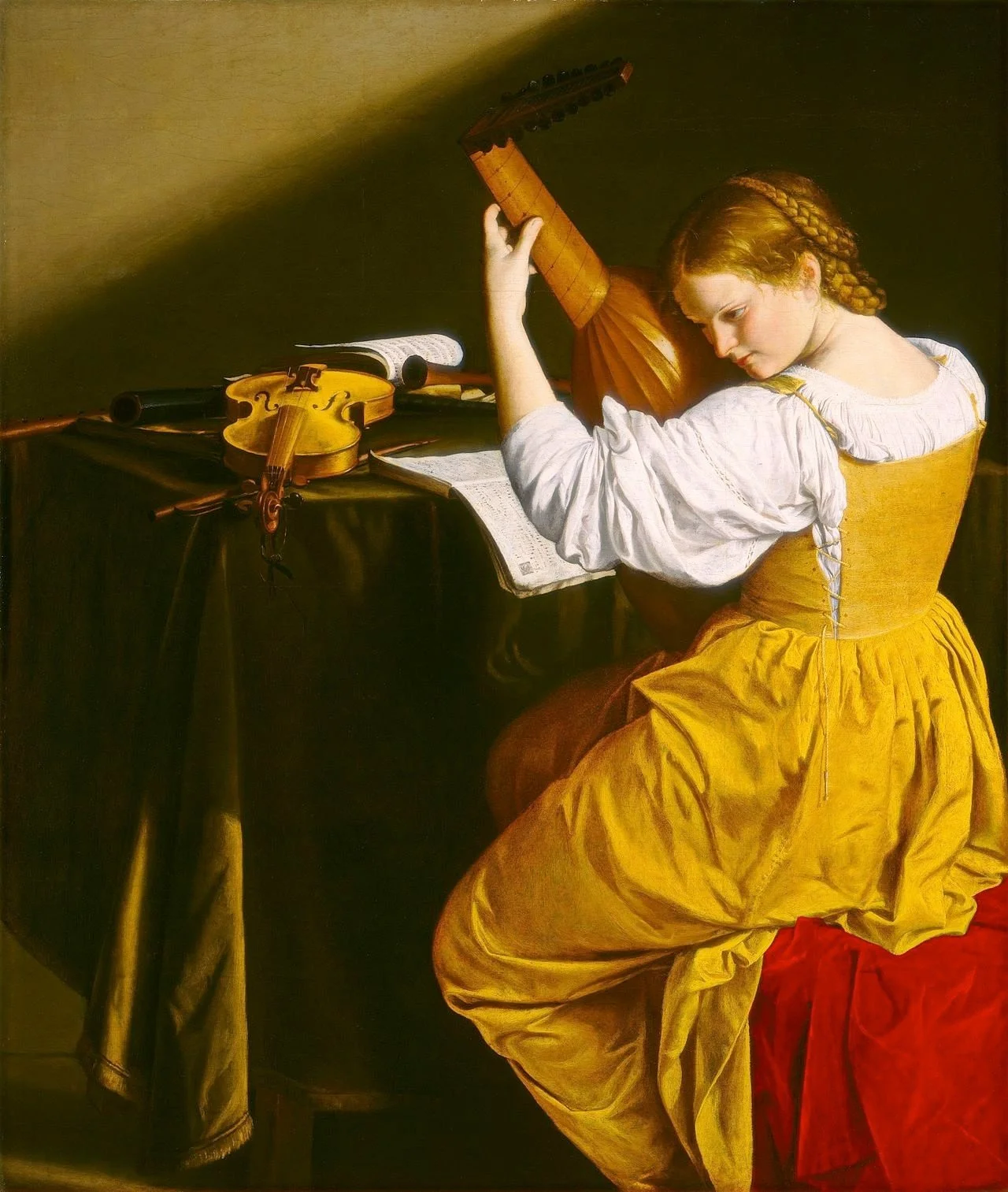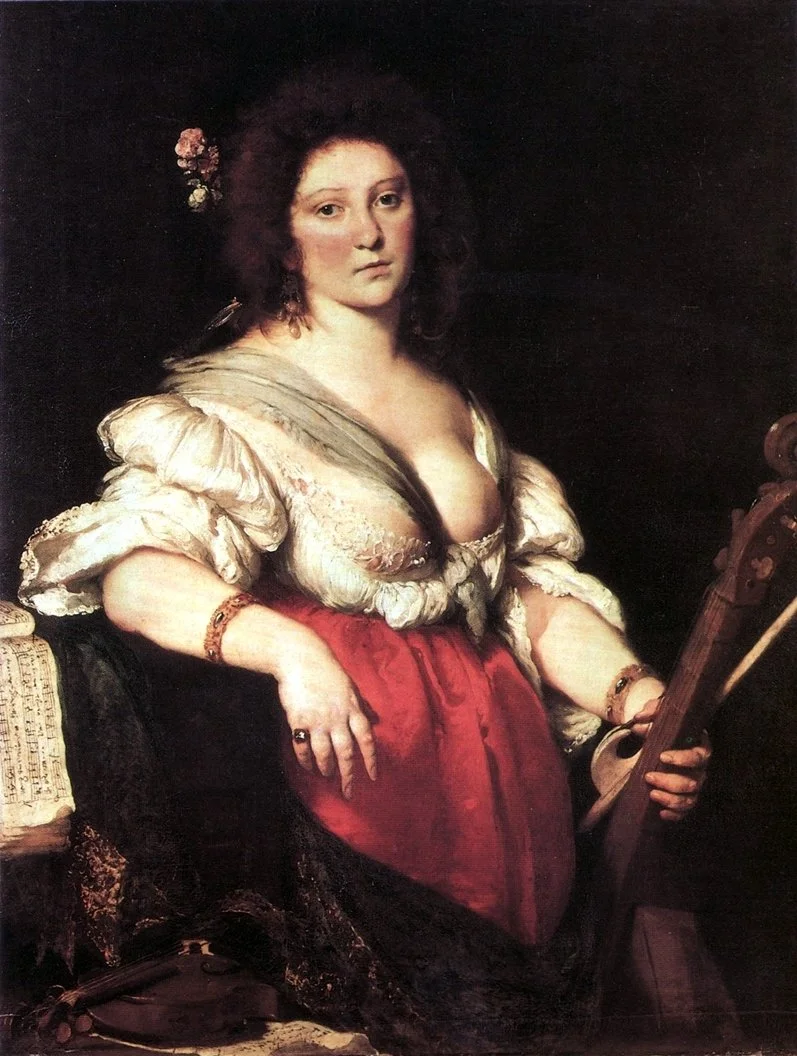Baroque Women Composers
Women have made significant contributions to music throughout history, and the Baroque era is no exception. In the 17th century, women composers made their mark, including Francesca Caccini, Barbara Strozzi, and Antonia Bembo. Many of these women were not only composers but also skilled professional singers, while others were nuns who composed music for their convents. Despite the limitations imposed on them by society, these women left a lasting legacy in the music world. Now, let's explore some representative works by some of the most prominent female composers of the Baroque era.
A Baroque depiction of music and intimacy.
The Lute Player by Orazio Gentileschi, c. 1612-1614, Oil on canvas (National Gallery of Art, Washington, D.C.)
Cosimo Bottegari, a Florentine musician at the Tuscan court, included in his lute book an arrangement for solo voice and lute, possibly with text by Isabella de Medici, a talented musician and poet, in ⏵︎ “Lieta vivo et contenta.” This arrangement is based on a madrigal, likely by Filippo de Monte, from a collection of 6-voice madrigals. Bottegari, unaware of the composer, titled it "di Autore Incerto," and a later hand added “idest Sra Isabella Medici.” to the manuscript.
Similarly, ⏵︎ “Per pianto la mia carne,” in the same lute book, bears the heading “Della Illus.ma et Ecc.ma S.ra Leonora Orsina Duchessa di Segni.” Whether this heading implies attribution or dedication remains uncertain. Consequently, we can't definitively establish if Leonora composed it or it was dedicated to her. Nevertheless, these compositions underscore noblewomen's involvement in music, both as creators and patrons.
Lucia Quinciani's ⏵︎ “Udite lagrimosi spirti d'Averno” was published in Venice within Marc'Antonio Negri's anthology titled "Affetti amorosi" (1611). This composition stands as the known solo monody by a female composer.
“The Viola da Gamba Player”, portrait of Barbara Strozzi, by Bernardo Strozzi, c. 1630s.
Numerous women, recognized as singers, are reported to have composed music for their own use, further blurring the line between singer and composer. The sisters Francesca and Settimia Caccini, for example, are credited with composing pieces they sang.
Francesca Caccini’s ⏵︎ “Maria, dolce Maria” illustrates again Francesca's ability to convey the meaning of words through sound. It is a song in praise of the Virgin Mary in her role as a comforter. The basso continuo is simple, varying in rhythm only when absolutely necessary to avoid monotony, with slow changes. Chromaticisms subtly add tension, and there are several dissonances. The harmonic climax comes on the phrase “ogni affano acqueta,” with a strong discord expressing anguish before the soothing effect of the cadence. “Maria, dolce Maria,” when better known to the musical public, should rank with “Amarilli” and even with Monteverdi’s “Lamento d'Arianna” as one of the most moving and unforgettable examples of early Italian solo song. It is haunting in flavor, descriptive in mood, and satisfying in form and content.
Caccini's music represents the Virgin's motion through celestial space as bringing this particular song into being - as composing it. Like most early seicento Florentine sonnet settings, ⏵︎ “Chi è costei” is a modified strophic song that textually and musically moves from a problem (in this case the question) to its resolution (in this case the confirmation that the text speaks as the “Court of paradise”) through subtle variations on a single set of harmonic and motivic ideas.
Francesca Caccini's ⏵︎ “Lasciatemi qui solo” is another notable work from the era, a lament sung from the perspective of a man mourning the loss of his lover. Francesca crafted a strophic song that fused Monteverdi's opening gestures with her own mastery of tonal desire. Above a glacially slow bass line and harmonic rhythm, the singer first asks for solitary death in the mid-range. Falling very slowly through successive phrases, the singer's voice reaches what will come to seem, in later stanzas, like its inevitable goal—the quoted refrain “lasciatemi morire.”
Regarding Settimia Caccini, Jacopo Cicognini remarks, “The music of the aforementioned songs was composed by the same women who sang them: (...) the second with exquisite refinement by Signora Settimia, (...) being the daughter of the renowned Giulio Romano.” A number of songs accompanied by basso continuo composed by Settimia Caccini have indeed been preserved in two associated manuscripts, alongside compositions by her husband Alessandro Ghivizzani. Examples include ⏵︎ “Già sperai” from “Ariette in musica da diversi maestri,” Lobkowicz Music Collection, MS II La 2, and ⏵︎ “Due luci ridenti” from I-Bc MS Q49.
Barbara Strozzi is undoubtedly the most renowned and celebrated female composer of the Italian Seicento, and her acclaim is well-deserved, owing to her prolific contributions to vocal music. In her “Sacri musicali affetti,” featuring some of the earliest spiritual cantatas, Strozzi highlights her place as a female composer in a man's world. She concludes her “Sacri musicali affetti” with sycophancy characteristic of the age: “on the lightest leaves, I fly in devotion to bow down before you.” Barbara Strozzi's marian motets ⏵︎ “O Maria” and ⏵︎ “Salve Regina” are two stunning examples of her compositional skill. These pieces are deeply emotional prayers to the Virgin Mary, showcasing Strozzi's ability to depict intense feeling through music.
Francesca Campana Romana, possibly a singer herself, published "Arie" in 1629, featuring the monody ⏵︎ “Semplicetto Augellin,” suggesting her dual role as both performer and composer. Her ability to fuse Monteverdi's style with her tonal expression shines through her strophic songs.
The ⏵︎ “Lamento della Vergine” addresses the crucifixion from the perspective of the Virgin Mary. Its setting in F minor, appropriately chosen to lend its effect to the scene of acute distress, recalls the alternate key signature for “Habbi pietà di me”; it appears nowhere else in Produzioni armoniche. The cantata contains twelve sections, with the actual lament appearing in the sixth section as its literal centerpiece. Bembo apparently modeled the entire piece after Strozzi’s “Il Lamento,” Op.2 (1650), which dramatizes the beheading of Henri de Cinq Mars in 1642.
While the Italian works testify to the composer’s skill in setting her own language to music, two layers of pieces in “Produzioni armoniche” show the influence of the French soundscape. The french Air ⏵︎ “Ha, que l’absence,” joins the tradition of popular urban song in Paris at the turn of the eighteenth century. The manuscript’s final piece and its sole one in French, the Air follows the musical and textual lines of the airs sérieux et à boire.
Many women composers of the Baroque era were nuns, and convents in Bologna and Milan were known for nurturing musical talent. These women, such as Lucrezia Orsina Vizzana, Chiara Margarita Cozzolani, and Rosa Giacinta Badalla, published their music and attracted audiences beyond the convent walls.
Lucrezia Vizzana's “Componimenti musicali” includes several pieces centered on themes like a nun's relationship with Christ, spiritual union, and heavenly devotion. Her ⏵︎ “O magnum misterium” is an intense meditation on the mysteries of the Passion.
Isabella Leonarda wrote ⏵︎ “Ave suavis dilectio,” a solo communion motet, as part of her Opus 6 collection, published in 1676. She likely wrote the Latin text herself. It is a good example of the Baroque “modern” style with its highly ornamented vocal line, word painting to reflect the text, and with instrumental ritornelli separating segments.
Rosa Giacinta Badalla of Santa Radegonda in Milan, and others, too, published their music, which was enthusiastically received beyond convent walls. Laypersons attended convent musical performances to hear the “disembodied voices” of the nuns emanating from behind convent screens, which must have seemed otherworldly, like choirs of angels. Her motet ⏵︎ “Non plangete” was written “Per la Natività della Beata Vergine Maria” and published in her one printed collection “Motetti a voce sola”, Venezia, 1684. It is a remarkable work among Milanese solo motet books for its patent vocal virtuosity, motivic originality, and self-assured compositional technique.
Donna Bianca Maria Meda's ⏵︎ “Cari musici” from “Motetti a 1.2.3.4.” takes a unique approach, serving as an apostrophe to musicians about the limitations of earthly music compared to divine contemplation. This work encapsulates the seventeenth-century notion of music's fallibility in comparison to celestial harmonies awaiting the saved soul.
To further explore these works, you can listen to my YouTube playlist ⏵︎ “Women Composers from the Baroque Era,” featuring score animations with transcriptions available for purchase on my website. Studying and performing these pieces can help us celebrate the contributions of these remarkable women and inspire future generations in the world of music.
References:
Bowers, Jane M. (1993). "Strozzi, Barbara." In The New Grove Dictionary of Music and Musicians. Oxford University Press.
Bowers, Jane M. (1992). "Caccini, Francesca." In The New Grove Dictionary of Women Composers. Macmillan Publishers.
Carter, Tim (2001). "Bembo, Antonia." In The Oxford Companion to Music. Oxford University Press.
Dunbar, J. C. (2020). Women, Music, Culture: An Introduction. United Kingdom: Routledge.
Fontijn, C. (2006). Desperate Measures: The Life and Music of Antonia Padoani Bembo. United Kingdom: Oxford University Press.
Raney, C. (1965). Introduction to Francesca Caccini. The NATS Bulletin, 22, 12-15.
Women Making Music: The Western Art Tradition, 1150-1950. (1986). United States: University of Illinois Press.
D'Accone, F. (2003). Corteccia's Motets for the Medici Marriages of 1558.
Weaver, E. B. (2007). Convent Theatre in Early Modern Italy: Spiritual Fun and Learning for Women. Cambridge Studies in Italian History and Culture. Cambridge University Press.
Bowers, J. (1986). The Emergence of Women Composers in Italy, 1566–1700.
Cusick, S. G. (2015). Francesca Caccini at the Medici Court: Music and the Circulation of Power. United Kingdom: University of Chicago Press.
Creative Women in Medieval and Early Modern Italy: A Religious and Artistic Renaissance. (2016). United States: University of Pennsylvania Press, Incorporated.
Cusick, S. G. (1998). "WHO IS THIS WOMAN...?": Self-Presentation, "Imitatio Virginis" and Compositional Voice in Francesca Caccini's "Primo Libro" of 1618. Il Saggiatore musicale, 5(1), 5-41. Casa Editrice Leo S. Olschki s.r.l.

